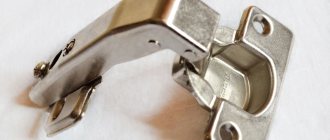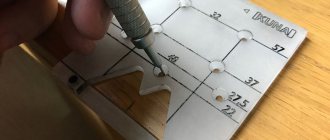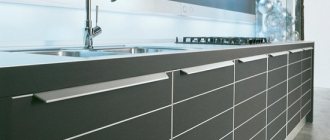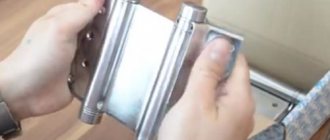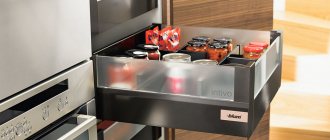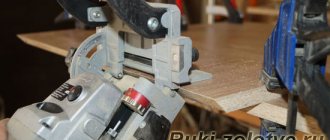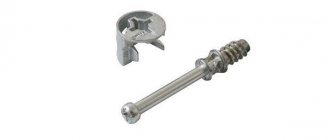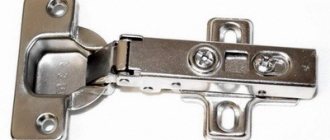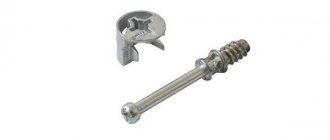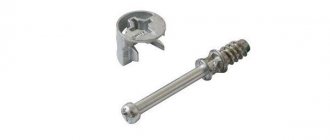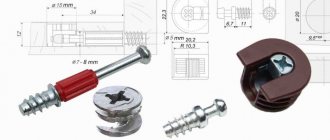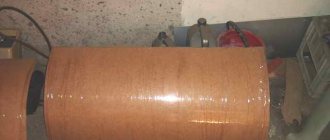Introduction
Currently, there are a great variety of styles and designs of kitchen sets. To the delight of modern housewives, we have already moved far away from the standard forms of floor and wall cabinets. Nondescript, dull laminated chipboard doors, similar decors and handles remain only in memories and old photographs. Today, housewives have kitchen sets of all styles, shapes and colors! We can see both irreplaceable classics with facades made of natural wood, and modern urbanism, moving away from standard forms and lush excesses. Built-in kitchen units with corner cabinets, which in many cases are covered with radius facades, are now in fashion. Bent doors are made both from MDF for a modernist style, and from solid wood with veneer for an essential classic.
Typical parameters of radius facades
Built-in kitchens require a certain calculation and design of the size of the cabinets, and, accordingly, the doors to them. This leads to the reconfiguration of equipment each time to produce one or another piece of furniture of a non-standard size, and as a result, an increase in the cost of the entire set. Therefore, many manufacturers adhere to standard parameters for the manufacture of facades, including radius ones. Bent doors are not used as often as straight doors, so the range of their standard parameters has fewer options. Such a characteristic as the material of manufacture for a rounded facade is limited to only two types - MDF (HDF) and natural wood (solid wood and veneer). But these materials are sufficient for the production of various types and styles of furniture sets. The only negative is the impossibility of producing bent doors for economy-class furniture, in the production of which only laminated chipboard is involved.
The next parameter for the described facades is the dimensions. The range of standard sizes for radius doors has a smaller choice of options than for straight doors. Curved facades are usually made with the following heights: 536, 573, 716, as well as 956 and 1316 mm, and the width is selected from the standard parameters of straight doors and measured along the side edges. Another important value is the bending radius. The safety and ergonomic operation of the kitchen depends on it. This characteristic is also standardized. Most often, manufacturers use a radius of R-240 mm.
Selection of hinges for radius facades
The furniture market currently offers a wide range and variety of types of hinges for furniture facades. According to technical characteristics, hinges are divided into those with a built-in closer and those without it. There are hinges for overhead doors that cover the ends of the side walls of the frame. They are also available for adjacent ones, when used, the façade half covers the edge of the side of the cabinet. There are also hinges for inset doors; they are used when the door does not protrude beyond the depth of the cabinet frame.
There are also awnings for corner doors, with an angle of +30⁰, +45⁰ and +90⁰. The latter, with an angle of 180⁰ (or +90⁰), are used to install the curved facades discussed in this article. Such hinges are also called inverse hinges, and furniture manufacturers designate them as “false panel” hinges. When installing such a hinge, the door forms a straight line with the wall on which it is installed.
When installing a radius facade on these hinges, a problem with the door slamming often arises. The facade does not close completely, even if the hinge is selected with a closer. This problem occurs due to incorrect cabinet or door geometry. In order not to redo the façade and not waste additional resources of time and money, the problem is solved by installing hinges with an even larger closing angle or changing the height of the mounting strip using a wedge strip. The presented article should serve as an assistant to both the manufacturer of kitchen furniture and the housewife who will rule over it in selecting the required size of the curved facade and its correct installation on site, if its use is necessary in the design of the set.
For glass doors
Four-hinged hinges are used to connect the glass door to the facade. For such products, you will need to not only insert a high-quality device, but also a loop that has a beautiful external shape. The ability to open moving parts in three planes is one of the advantages of these hinges.
Hinges for glass doors are manufactured and installed taking into account the fragility of the material.
For glass in the design of the connecting device, a cup made of plastic material. There is a seal ring. On the visible side, you can choose a loop with a decorative plug. It can be semicircular or round in shape. Also currently on sale there are products with different colors.
According to the installation method, furniture hinges for glass doors are available with or without drilling.
The manufacturer of this type of product equips them with high-quality connections that can withstand a large number of opening/closing cycles. It is important that such furniture hinges have no defects and that they have an aesthetic appearance.
If the glass is darkened, you can choose a dark hinge. When selecting a specific facade, you can choose any of the types: internal, external, semi-overlay, screwless, self-closing, fastened at the desired angle.
Invoices
This is a front that completely covers the front side of the box.
It is attached to overhead hinges.
With their help, it completely covers the sidewall of the box (of course, with the exception of the gap) to which it is attached.
When closed, the installation angle (the angle formed between the side of the box and the plane of the facade) is 90 degrees.
The opening angle (the angle between the side of the box and the plane of the facade in the open position) is 110 degrees.
This option is used when you simply need to cover the box with one or two facades that are attached to its side walls.
Semi-overhead
This is a type of overhead front with the only difference that when installed on semi-overlay hinges, it overlaps the side of the box (on which it is installed) by half (not counting the gaps).
The installation angle and opening angle in this case are the same as for the overhead one.
Semi-overlay hinges (they are also called “middle” hinges) are used when the facades are attached to a common partition and must open in different directions.
If in this case you use overhead ones, then the fronts will be impossible to install, since each of them will tend to cover the partition (on which it is attached) completely.
Internal (inset)
They are located inside the box and do not overlap the sides. They can be attached both to the sides of the box and to its partitions (in this sense, inset facades are universal). The installation angle of this hinge is 90 degrees, the opening angle is 100 degrees.
Corner facades 45 degrees
They are used on corner boxes, the width of the side parts of which is the same (for example, this box).
The installation angle of the hinge used in this case is 45 degrees, the opening angle is 95 degrees.
Deaf
In some cases, the front has to be attached not to the side part of the box, but to its overhead strip located in the front plane of the box.
For these purposes, gallery loops are used (they are also called “blind”).
They have an installation angle of 180 degrees and an opening angle of 90 degrees.
The dimensions of the installation angles and opening angles given here are approximate, as there are many variations of this fittings (of the same type) produced by different manufacturers.
Now we understand the principles of attaching facades to boxes, and we can take a more detailed look at the hinges themselves and their insertion, but so that you don’t get a “mess” in your head, we’ll do this review another time.
Types of furniture hinges by design
There are many hinges and canopies used to attach a swing door to the frame of a cabinet or cabinet. Basically, in modern furniture production, four-hinged hinges , which allow the facade to be adjusted in three planes at once:
All of them consist of two interconnected parts - a bowl with an elbow and a strike plate . Often the strike plate is called a mounting or mounting plate. This article will focus specifically on four-hinged hinges.
Other types of furniture hinges can be combined into one large group as “bowlless” hinges.
piano hinges, card hinges, pin hinges, and heel hinges, known to everyone for fastening interior doors and facades in old furniture . They are rarely used in modern furniture. For example, piano, card and mortise hinges can be used to attach tabletops to the base, movable legs in book-tables. For ordinary cabinets, brass decorative hinges are used as additional decor.
Overhead hinges that do not require drilling of the facade . They come in handy when the thickness of the material chosen for the facade does not allow installing (embedding) a four-hinged hinge due to the depth of the bowl. The only drawback of such hinges is their rigid fastening, which does not allow adjustment in three planes, like four-hinge hinges.
Materials for manufacturing accessories
In the manufacture of furniture hinges, various metals are used, but the main condition for manufacturers is their ability to hold their shape and not deform, reliability and resistance to long-term use. When choosing hinges, it is necessary to take into account not only functional features, but also the quality of the material.
The most popular are hinges made of steel or brass. They have a long service life, they are almost impossible to break or disable when used for their intended purpose. In addition, such products are not subject to corrosion and deformation.
Steel furniture hinges
Types of four-hinged furniture hinges
According to the design, according to the way the bowl with the knee is attached to the striker, four-hinge furniture hinges can be of three types:
- Slide-on—the parts of the loop are inserted into each other and connected using a fixing screw that has special notches, thanks to which it reliably “holds” the connection even in a weakened state. This type of loop is the most common.
- Clip-on - the parts of the loop are connected by simple snapping, without screws. The facade can be removed and installed without using any tools - just pull the latch. Clip-on hinges are also called quick-installation hinges.
- Key-hole – on the shoulder of the bowl with a knee there is a hole resembling a key hole in shape - a keyhole. The arm and bar are secured by passing the head of the fixing screw through this hole.
Regardless of the design, all of the above types are divided according to their purpose and installation method - what facade is used in the furniture and how it is attached to the body.
90 degree hinges
*The designation 90 degrees in this case is conditional, it is used to mark hinges that open at a right angle. In fact, the door travel is somewhat greater, reaching about 105-120 degrees when opening. Some manufacturers and sellers of accessories may label this type not “loop 90”, but, for example, “loop 110” - there is no mistake here.
The 90 degree overhead (external) loop has a straight “shoulder”, without bending. Used for facades that completely cover the ends of the side walls of the body (without taking into account the technological gap, which can be 1-5 mm).
Half-overlay (middle, half-outer) loop 90 degrees , the shoulder of the bowl with the knee can be distinguished by a medium bend. Rarely used. For example, in kitchen two-row horizontal cabinets for attaching the bottom door and in three-leaf wardrobes for attaching the middle facade.
The 90-degree inset (internal) hinge is distinguished by a large bend on the “shoulder”, due to which the inset door is carried out when opened outside the body. Rarely used. For example, in office furniture, in which the body is made of thickened 22 mm chipboard and the internal facade emphasizes this detail.
180 degree hinges
A straight (gauge) hinge for false panels is designed for attaching the facade to the sidewall, which is located in the same plane. Most often used in corner kitchens, when using the appropriate corner sink module.
The 165-degree carousel (crab, crocodile, transformer) hinge is recognizable by the characteristic complex shape of the bowl's elbow, which ensures that the door opens completely relative to the body - almost up to 180 degrees. It can also be invoice, semi-invoice and inlay. Differs in the shape of the shoulder.
Types of corner hinges
A 30-degree corner hinge “presses” the façade, located at an angle of 90+30 degrees relative to the body. It is most often used in beveled end cabinets of kitchen units or wardrobes. Installation angle – 120 degrees. Some manufacturers mark it by installation angle, i.e. called a 120 degree loop.
The 45 degree corner hinge is used in trapezoidal single and double door cabinets - for example, kitchen or dressing rooms. Similar to the previous type, it can be called by the angle of installation - a 135 degree loop.
An angular loop of 120-135 degrees most often serves as a connection between two facades, fastened together at a right angle of 270 degrees, which come off like an accordion. In this case, the door without a handle is attached to the body using a carousel hinge from the previous category.
Corner hinges with a negative opening angle are used extremely rarely, due to design features: end cabinets, as a rule, serve as the end of a row of furniture and it is more convenient to open the door from the other side. But there are projects in which it is more expedient to implement the opposite solution.
Hinges for facades. Scope of application and installation
I propose to consider (as promised in the previous post) what furniture hinges can be, what facades they are used for, and which ones are used most often.
So, the hinge is a mechanism by which the hinged door of the module is attached to the frame.
By their very definition, one can understand that these are quite important elements of furniture, and the quality of a particular product depends on them, to some extent.
Doors on designed furniture can be very different in installation.
They can be overhead, semi-overlay, inset, corner, blind, carousel, non-standard, in short, the most diverse.
So, for each type of front fastening, there are loops (and if there are none in nature, then they can be “adjusted” to the desired angle. But more on that later).
We will consider options for attaching fronts, which are found in the vast majority of cases.
Is it possible to purchase such loops now?
You can try to buy old-style hinges at any hardware store or order them on the Internet. They are often posted on Avito.
Despite the fact that many improved models have appeared, they are still in demand due to their reliability, ease of use and inexpensive cost.
Furniture hinges are important elements of furniture, because the ease of use of structures, functionality and even aesthetics depend on them. Therefore, you should pay special attention to the choice of cabinet fittings, since there are different types and varieties of furniture hinges, and each variation will be more advantageous in different cases, when assembling different types of furniture. Today we will look at the most common types of hinges, features of their structure and installation.
Invoices
This is a front that completely covers the front side of the box.
It is attached to overhead hinges.
With their help, it completely covers the sidewall of the box (of course, with the exception of the gap) to which it is attached.
When closed, the installation angle (the angle formed between the side of the box and the plane of the facade) is 90 degrees.
The opening angle (the angle between the side of the box and the plane of the facade in the open position) is 110 degrees.
This option is used when you simply need to cover the box with one or two facades that are attached to its side walls.
Semi-overhead
This is a type of overhead front with the only difference that when installed on semi-overlay hinges, it overlaps the side of the box (on which it is installed) by half (not counting the gaps).
The installation angle and opening angle in this case are the same as for the overhead one.
Semi-overlay hinges (they are also called “middle” hinges) are used when the facades are attached to a common partition and must open in different directions.
If in this case you use overhead ones, then the fronts will be impossible to install, since each of them will tend to cover the partition (on which it is attached) completely.
Internal (inset)
They are located inside the box and do not overlap the sides. They can be attached both to the sides of the box and to its partitions (in this sense, inset facades are universal). The installation angle of this hinge is 90 degrees, the opening angle is 100 degrees.
Corner facades 45 degrees
They are used on corner boxes, the width of the side parts of which is the same (for example, this box).
The installation angle of the hinge used in this case is 45 degrees, the opening angle is 95 degrees.
Which furniture hinges are best for kitchen cabinets?
It is worth considering that when choosing this product for a canopy on the doors of a kitchen unit, you should adhere to the following criteria:
- When buying a furniture hinge, you need to take into account the design of the cabinet for which it is selected. The standard type of kitchen set is equipped with overhead and semi-overhead products. For built-in wardrobes you need to purchase inverse ones. If the type of opening of the moving parts occurs horizontally, for example, the top, then you should opt for mezzanine hinges, which have automatic latching.
- Diameter of the landing cup. This is a specific notch in the loop. It should cut into the façade according to the previously planned markings. When choosing this item, you need to take into account the weight of the door and its dimensions. For regular opening parts, you can take a universal hinge with a 35 mm cup. For lightweight ones – 26 mm, for heavy ones – 40 mm.
- Installation angle. These types of hinges can be divided into standard 90 degree hinges, which are installed on a larger number of cabinets. For corner facades made according to individual drawings, it is worth buying furniture hinges with a changed angle or adjusting pads under them to reduce the possibility of the door swinging open.
- The material from which the fittings are made. Various alloys are used for this type of product: aluminum, copper, zinc, brass. Experts advise familiarizing yourself with the durability characteristics of these materials. Brass and steel hinges are considered the most reliable. They are resistant to corrosion and do not rust in environments with high humidity.
- Determine for yourself the required number of hinges per sash. Usually these are two products. A distance of 0.50 m should be maintained between them, and 15 cm from the edge. If the kitchen should contain furniture made of heavy solid wood, then it is worth distributing the load over 3-4 hinges.
When facade hinges are purchased, then the installation can be entrusted to specialists and done independently, taking into account the basic installation rules.
To select the optimal model, you need to familiarize yourself with the main technical and operational parameters of each type.
